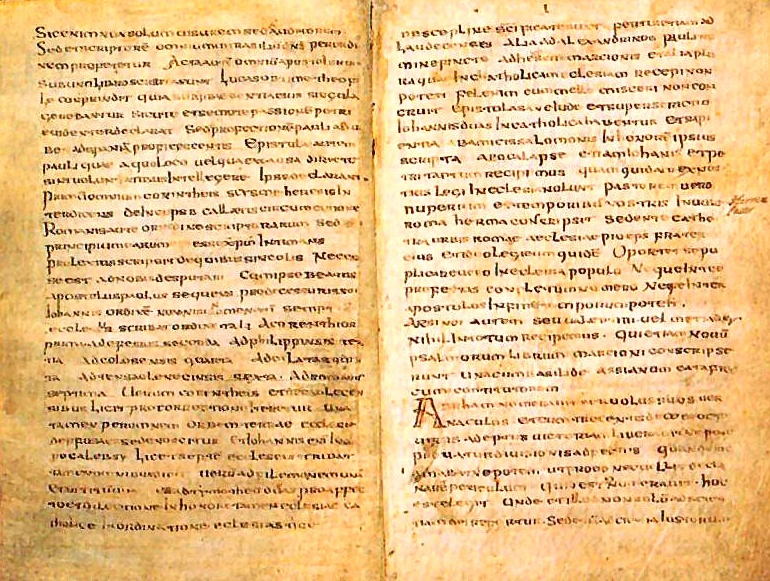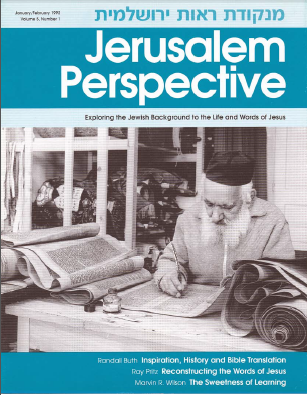How to cite this article: Ray Pritz, “New Testament Canon,” Jerusalem Perspective 36 (1992): 10 [https://www.jerusalemperspective.com/2629/].
When discussing the question of inspiration of Scripture, it is important to consider also the way in which the church determined which books were from God and which were not. Most of us take for granted that the New Testament always had twenty-seven books. We may be vaguely aware that Paul mentions a letter he wrote to the church in Laodicea (Col. 4:16) and that there might have been a third letter to the church in Corinth, but beyond that we assume there were no other writings.
In fact, the writing of the books included in the New Testament was spread over a period of more than half a century. However, not all of these books were accepted by the churches as coming from God until about three hundred years after they were written. During that period there were other books, written roughly at the same time as the twenty-seven New Testament books, which were accepted by some churches as inspired.
One of the earliest acknowledgments that parts of what we now call the New Testament were to be considered as holy Scripture alongside the Hebrew Bible comes in the words of Peter, when he sets writings of Paul together with “Scripture,” in other words the Hebrew Bible: “…just as our dear brother Paul wrote to you, using the wisdom that God gave him…. There are some difficult things in his letters which ignorant and unstable people explain falsely, as they do with other passages of the Scriptures” (2 Pet. 3:15-16).
First Lists

The first actual attempt to draw up a list of books to be accepted was made by a man named Marcion in the middle of the second century A.D. Marcion, under the influence of gnostic teaching, rejected the idea that the God of the Hebrew Bible could be the same as the God and Father of Jesus. The Jewish God, he said, was a God of wrath and judgment, while the God revealed by Jesus is a God of love and compassion. Following this essentially anti-Semitic idea, Marcion rejected all of the Jewish Scriptures. He then accepted as truly inspired and authoritative only the writings of Paul (ten books, not including the letters to Timothy and Titus) and the bulk of the book of Luke. Because he believed that Jesus only appeared to be a man and to suffer (a view known as Docetism), he rejected the first two chapters of Luke which speak of the birth of Jesus. Marcion was declared a heretic even in his own lifetime.
By the end of the second century there was wide (but not yet universal) acceptance of all but four of the books which make up our New Testament. The so-called Muratorian Fragment dates from that time and omits Hebrews, James and 1 and 2 Peter. The eastern and Egyptian churches were also slow to accept 2 and 3 John, Jude and Revelation. The name “New Testament,” describing the apostolic books of the church, was first used in about 193 A.D. by an unknown author writing against the heresy of Montanism.
Even as late as the early fourth century, the church historian Eusebius was able to point out that books like the Shepherd of Hermas, Didache and the Epistle of Barnabas were accepted by some churches, while books like Jude, 2 Peter, Revelation and Hebrews were omitted by some (Ecclesiastical History III, 25). This situation is indeed reflected in some extant ancient manuscripts. For example, the Peshitta (Syriac), which dates from the fourth or fifth century A.D., omits 2 Peter, 2 and 3 John, Jude and Revelation.
Final Canon
It was not until the year 367 A.D. that the Alexandrian bishop Athanasius listed the twenty-seven books which we now accept as the New Testament canon. The word “canon” derives from the Semitic root meaning a reed (kaneh) as a unit or standard of measure (cf. Ezek. 40:5). It was first applied to a set of biblical writings in the fourth century. Up until that time there had been no council or committee which sat down to decide which books were to be accepted by the whole church and which were not. The process was an organic one stretching over that period of 300 years. The main factors which ultimately determined whether a book was to be placed in the “New Testament” were 1) having been written by an apostolic figure, and 2) acceptance by long usage among the churches.
In certain respects, the process which led to the fixing of the canon is one of the outstanding statements of the inspiration of tradition and the wisdom of God manifest collectively in his church. While God had used individual writers to record the books themselves, the actual acceptance of those books as being from God was subject to a long transition, a process of testing. We might say that the Holy Spirit was allowing the collective wisdom of the church to test the books to see whether they were from God (cf. 1 John 4:1).



